Women in Tech Stats 2024
Uncovering Trends and Unseen Data by WomenTech Network
A Look at the Latest Women in Tech Statistics
The Tech industry has long been a male-dominated world but as we entered a new decade it is time to look at the position of women in tech.
Where are we now and where are we going?
At the current pace of change it will take
until the economic gender gap is closed.
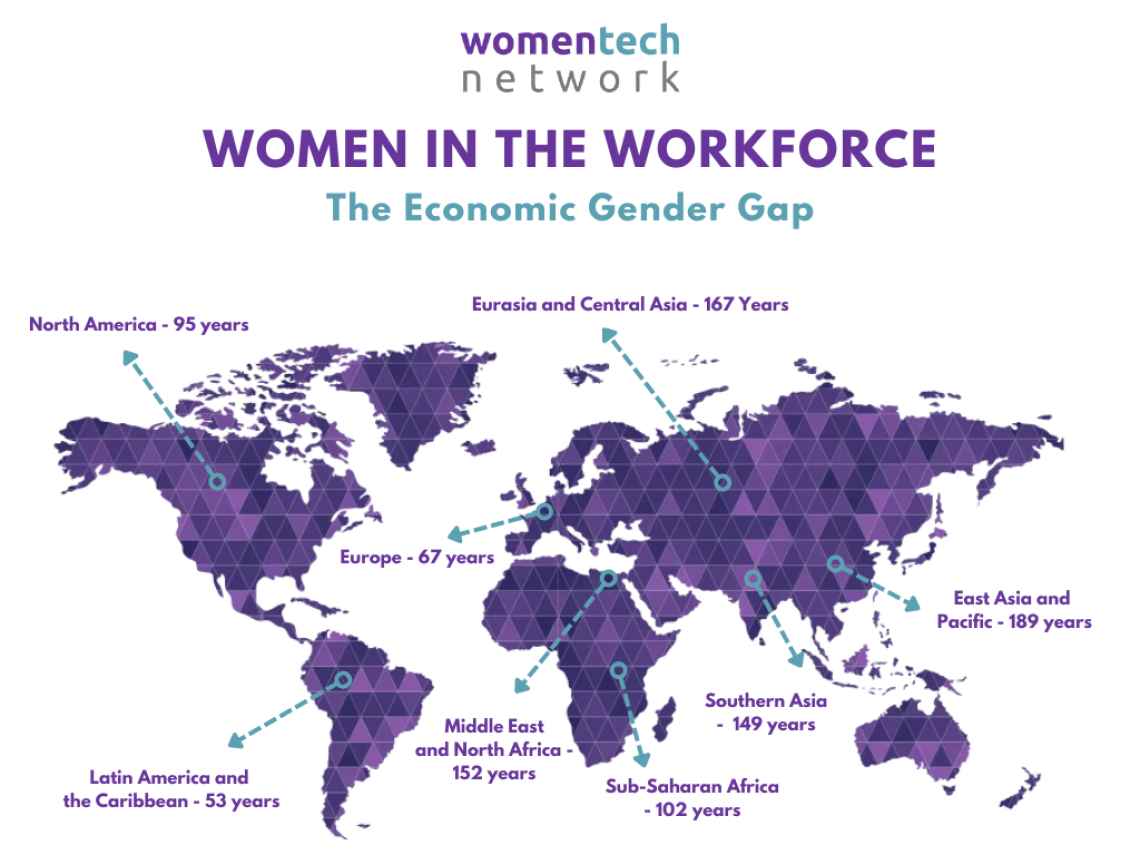
The Global Women’s Workforce
Recent studies have revealed that only 47.7%, less than half of working-age women are participating in the global workforce, and in some countries, this figure is even lower. This means that for every two men employed, there is only one woman. In addition to this, women earn less money than their male counterparts and are more likely to experience gender-based discrimination.
The majority of countries have seen an increase in female labor participation over the last decade, with emerging economies leading the way. However, progress has been slower in advanced economies due to a combination of varying economic policies and fewer incentives for women to return to work.
Global Workforce
Women in Tech and STEM Workforce in the U.S.
According to a report by The World Bank, women make up less than a third of the world’s workforce in technology-related fields.
- Women make up 35% of employees in STEM in the U.S.
- The United States science, technology, engineering, and mathematics (STEM) labor force represents only 25% of the total U.S. labor force.
- Women held 35% of tech jobs in the U.S. at the end of 2023
In major tech companies, women are in the minority. Specifically, at Amazon, Facebook, Apple, Google, and Microsoft, the proportion of female staff is 45%, 37%, 34%, 33%, and 33.1% of their entire workforce, respectively. When it comes to leadership positions, these figures are 29%, 34%, 31%, 28%, and 26%, respectively.

Gaps in STEM Education Graduate Stats
The gender gap in STEM fields is particularly concerning when it comes to specific academic disciplines. Women account for approximately 21.3% of those who earned a Bachelor's degree in computer and information sciences, 22% in Engineering and Engineering Technology, 35% with an Economics background, and 39% in Physical Sciences respectively (National Science Foundation).
The latest available data indicates some improvements, but disparities still exist. Although overall enrollment in STEM is slightly increasing, the participation of women and particularly women of color in certain fields like computer science remains disproportionately low. For instance, Black students accounted for about 8.6% of those earning computer science degrees, while Hispanic students made up around 8% of master's degree recipients in this field. These figures indicate ongoing challenges in achieving representation in STEM fields, reflecting broader trends of underrepresentation in both education and the workforce.

Hiring Trends & Retention for women in tech, minorities
Survey findings indicate 65% of tech recruiters acknowledge bias in hiring, with 66% of women lacking clear career advancement paths in their companies. In STEM roles at the federal level, 66.02% were White, followed by 14.58% African American or Black, 9.76% Asian, 6.42% Hispanic or Latina, 0.97% Native American/Alaskan Native, and 0.28% Hawaiian or Pacific Islander.
Women are 1.6 times more likely to face layoffs than men, often due to less seniority. Additionally, 57% of women in Technology, Media, and Telecom (TMT) plan to leave their jobs within two years, citing poor work/life balance. The 2022 tech layoffs disproportionately affected women, with 69.2% of those laid off being female, based on a WomenTech Network study of 4912 profiles from 54 companies.

Women in Tech Employment Gaps
U.S. Census data demonstrates that female workers have made enormous strides in the STEM workforce, growing from an 8% minority in 1970 to 28% of all STEM employees by 2019. Despite the progress made in 2023, there is still a considerable gender gap in the GAFAM (Google, Apple, Facebook, Amazon, and Microsoft) workforce with women making up between 29% and 45%. On average only 31% of the GAFAM employees are female.
As workers progress up the corporate ladder, gender discrepancies in employment become more and more pronounced.
Female representation in tech job applicant pools is highest for junior jobs. It drops for mid-level jobs and then drops again for senior-level jobs.
While software engineering jobs often have 25% fewer female applicants in their applicant pools between junior and mid-level (4 to 10 years of experience), ERP, UI/UX design, and cross-functional roles exhibit an even greater gender disparity with a drop at the senior level.
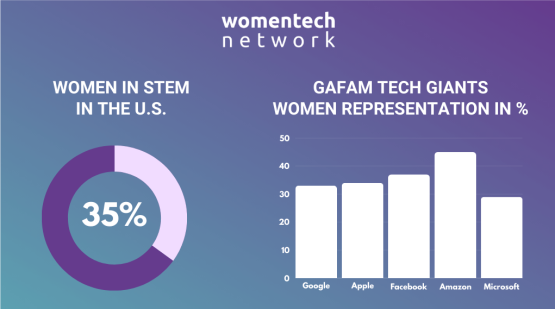
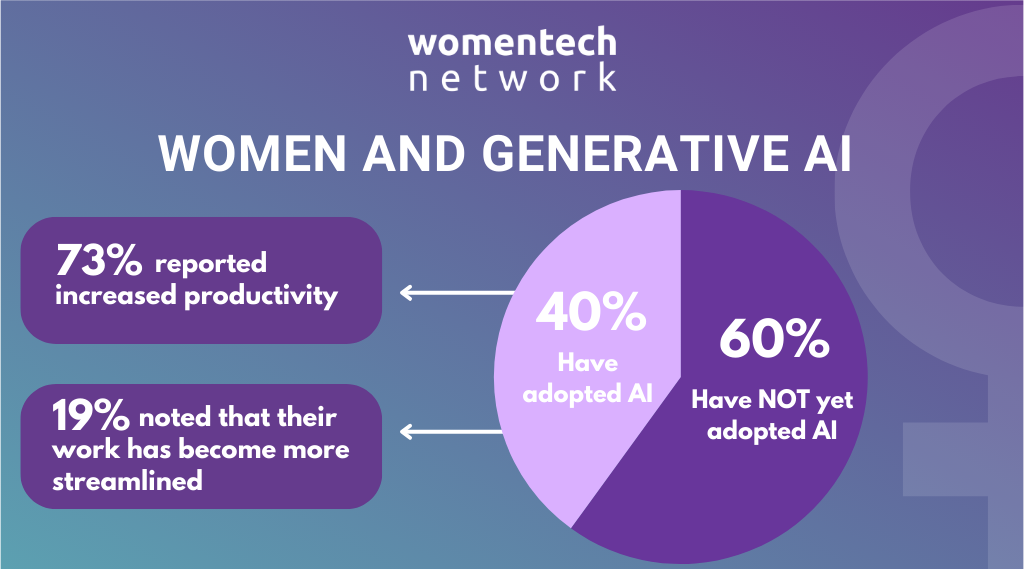
Women in Tech and Generative AI:
According to the Skillsoft Women In Tech Report 2024 60% of respondents were not yet using AI at work. Of the 40% who are, 73% have found they are more productive, and 19% find their work is more streamlined.
Boston Consulting Group Study Reveals 68% of Women in the Tech Industry Say They Use a GenAI Tool at Work More Than Once a Week, Compared with 66% of Men
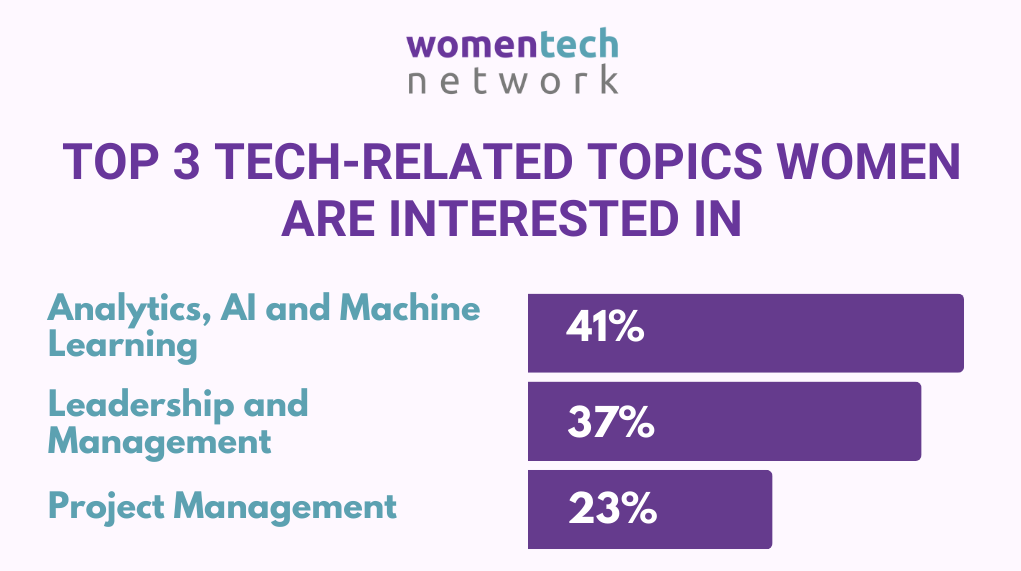
Re-Skilling Women in the era of Generative AI
For women, learning about AI and gaining skills in this field is crucial. AI, specifically Generative AI, is reshaping the future of work, with many industries increasingly relying on AI-driven technologies.
AI is the number one topic women want to learn about, but 63% report a lack of skills and access to training on the job.
C-suite executives across industries expect that, on average, 46% of workers will need to be reskilled in the next three years as a result.
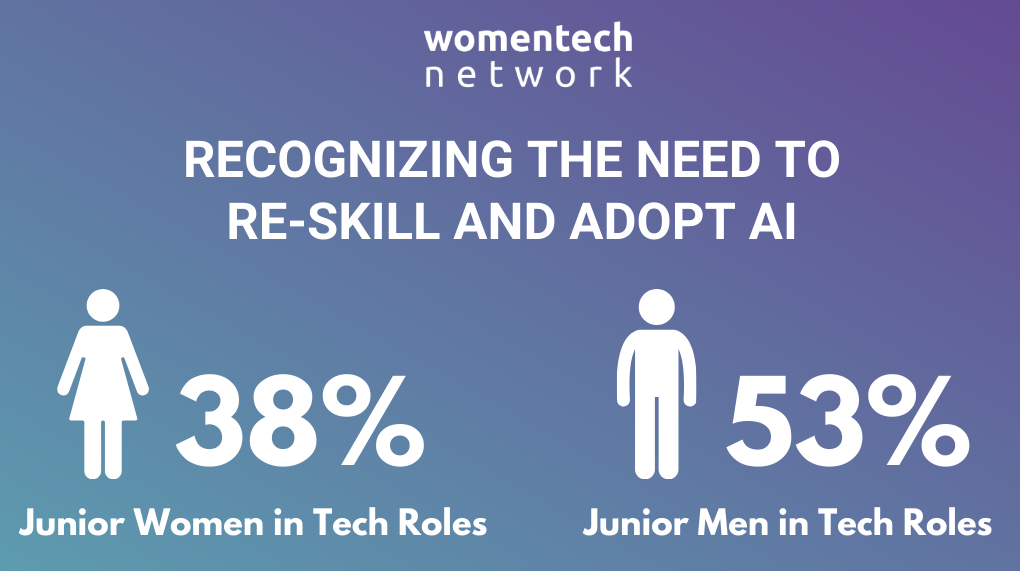
Adapting Women's Skills for the Generative AI Era
Only 38% of junior women in technical functions recognize the need to re-skill and adopt AI as a critical factor for their future job success, as opposed to 53% of junior men in technical roles.
The finding that all men are at a similar level of awareness about GenAI’s criticality for future job success and that this is not the case among women is concerning. Two reasons suggested in the BCG 2024 Report are that junior women do not have the same access to the networks and discussions where GenAI strategy is formed as do junior men, and that they are not equally represented in GenAI pilots and initiatives.
Workplace Culture Issues for Women in Tech
Women executives prioritize flexibility when contemplating joining or remaining with a company, with 48% citing it as one of the top three considerations in a WomenTech Network survey. Men leaders are slightly less likely to include this factor in their decision-making process, at 34%. Women executives are 1.5 times more likely than their male counterparts to have changed jobs because they desired a workplace that was dedicated to DE&I.
While remote and hybrid work may provide a temporary reprieve from bias, it is far from an adequate substitute for real systemic transformation. On the one hand, women are witnessing fewer microaggressions in virtual spaces; however, this should not be a cause to celebrate. Leaning on remote or hybrid models as a sole solution simply won't suffice.
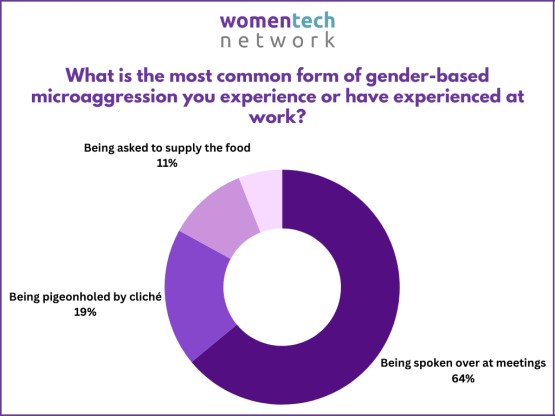
WomenTech Network survey further reveals that women often experience microaggressions at work. About 64% of respondents have been spoken over during meetings, 19% have felt pigeonholed by stereotypes in various situations, and 11% have been asked to “supply the food” during meetings. Amongst other frequent microaggressions, gendered language and taking meeting minutes were referred to as “the usual” from many of the survey participants.
Women in Tech in the C-suite
Despite incremental steps forward in the past decade, women—particularly those of color—are significantly underrepresented in corporate America. The situation is especially dire in senior leadership; only 25% of C-level leaders are women, and a mere 5% represent racial minority females. Undeniably, the "broken rung" continues to be an issue for many businesses, one that makes achieving gender parity within their organizations virtually impossible.
72% of women in tech report experiencing a prevalent "bro culture" at work, signifying gender discrimination. Meanwhile, 63% of those in engineering and IT roles have encountered this pervasive bro culture, a rate slightly lower than that of women working in other tech-related departments.

Pay Gaps for Women in Tech
It is undeniably true that men in STEM professions experience higher annual salaries than women - a difference of nearly $15,000 every year ($85,000 for males versus just $60,828 for females). This disparity is even more pronounced among Latina and Black women who are typically earning only around $52,000 per annum. Latinas earn nearly half of what the average white, non-Hispanic man makes, requiring them to work nearly 23 months more than any other group to bridge this pay disparity. Unfortunately, this wage gap is even more pronounced for Latinx women who have a college education.
A study in the U.S. showed that there was a gender wage gap of 1.6%. It also demonstrated that while women were paid less than men when working remotely, they seemed pleased to settle for $0.95 for every dollar their male colleagues requested as wages.
It also found that racial prejudice is a significant factor in the wage gap between female workers of color and white men, with Hispanic women and African Americans expecting to make only $0.91 for every dollar their counterparts receive.
Leadership Position Gaps for Women in Tech
In 2023, prominent female executives like Marne Levine of Meta and Susan Wojcicki of YouTube resigned. Alarmingly, none of the 'Big Five' US tech firms—Alphabet, Apple, Meta, Amazon, and Microsoft—have had a female CEO. Only 8-9% of women hold positions like CIO, CTO, or IT manager, or serve as technical team leaders.
The numbers are shocking; for every 100 men promoted to manager, only 87 women and 82 women of color get the same promotion. This leaves far fewer female candidates available for higher-level positions down the line, making it nearly impossible for them to ever catch up in terms of representation within these roles.
For every 100 men promoted to Manager, only 87 women and 82 women of color get the same promotion.
Venture Capital Funding for Women-led Startups
Women-led startups are having a daunting time obtaining venture capital funding, with only 2.3% of investment in 2022 going towards them. It's been proposed that female founders will experience more success if they approach investors who are also women - and it appears to be true since research shows that female VCs are twice as likely than male counterparts when providing money for businesses owned by women.
Only 25% of startups are founded by women, and 37% have at least one female member on their board of directors.
Recent studies, however, suggest that even though female-led startups may be more likely to secure funding from women investors, these investments also bring with them the idea of preferential treatment due to gender. This then leads to further complications for female founders when seeking additional investment down the line. In other words, obtaining early funds from a woman investor could potentially make it harder in the long run for an entrepreneur to receive financing elsewhere.
2.3% of women-led startups get funding
The COVID-19 Pandemic's Effect on Women in Tech
During the pandemic, women faced an unprecedented number of job losses - a staggering 5 million since February 2020. This is a significantly higher figure than that for men and reflects ongoing economic inequality between genders.
Throughout the pandemic and economic downturn, women working in the tech sector faced a likelihood of being furloughed or laid off that was twice as high as that of their male peers.
Additionally, women are usually expected to carry out the "invisible labor" of running a home and sadly, this situation only worsened during the pandemic. 80% of women planning to re-enter the workforce after a period of absence desire to switch careers and pursue STEM, as reported by MetLife's 2021 survey.
During the pandemic, 5 million women lost their jobs since February 2020
How to Create a Future for Women in Technology
Through an in-depth assessment of the latest HR and DEI standards, we have identified three distinct groups of measures to promote and maintain women's progress:
Over three-fourths of companies have already adopted table stakes, which are necessary but not sufficient to make tangible progress.
Companies with a greater representation of female and minority women are more likely to adopt best practices than those that settle for baseline standards.
Despite only being implemented by a fraction of companies, emerging practices have demonstrated remarkable results.
To expedite the progression towards gender equality in our society, it is imperative that organizations examine and embrace more emerging and leading strategies and establish new standards within their own operations.
Frequently Asked Questions
What percentage of women are in tech?
Currently, women make up about 35% of the tech workforce. This is a significant improvement from the early 2000s when women only made up 9%.
How many women work in tech in the US?
In the US, there are about 3.7 million women working in tech positions (which represents only 23% of the labor force).
How many women work in tech in Europe?
In Europe, there are approximately 1.7 million women working in tech positions (representing about 19.1% of the ICT labor force).

